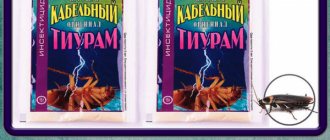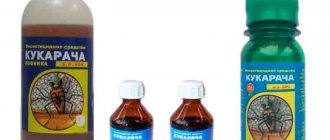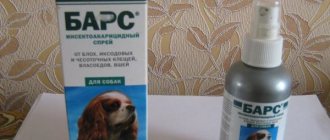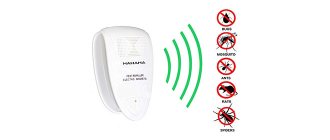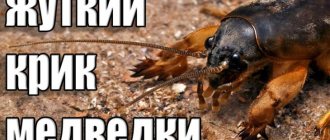The mole cricket is one of the pests that is extremely difficult to destroy. Conventional insecticides do not work on it, since the insect lives underground, gnawing tunnels in the soil and eating vegetables in the soil. Due to this feature of the insect, spraying beds with conventional insecticides will not lead to a positive result.
However, if you use information about the mole cricket with the aim of destroying it, then it will be quite possible to remove the pest from the garden. As a rule, to combat insects, traditional methods are first used: various traps and baits that allow you to collect insects and manually destroy them. But there are situations when the pest population becomes so numerous that it is not possible to catch and destroy all individuals manually. In this case, various chemical and biological control methods are used. One of the best drugs against mole crickets is Parachute, a special drug that is used to prepare poisoned baits.
Description of the insect and the damage caused
The mole cricket is a dark brown insect.
The length of the body is 5–8 cm. The pest has a gnawing type jaw apparatus. The body of the mole cricket is covered with a hard shell. At the base of the insect's cephalothorax are digging legs. Thanks to them, the mole cricket moves underground. At the end of the pest's abdomen are thread-like appendages. The front claws are well suited for digging in the soft soil of beds and agricultural fields. The activity of the insect depends on the time of year and the state of the environment. The peak of the harmful activity of the mole cricket occurs in the summer. The insect is omnivorous.
The mole cricket absorbs the root part of cultivated plants and leaf mass. By digging through winding underground passages, it sprinkles soil on the seedlings, which leads to suppression of their vital activity and death. Owners of dachas and vegetable gardens are trying to get rid of mole crickets forever in order to ensure good productivity of their plots.
When are protective equipment needed?
The orthoptera pest loves soil fertilized with humus, horse and cow manure. Medvedka:
- has good adaptive abilities;
- Reacts sensitively to increases and decreases in temperature;
- detects danger.
The pest prepares for winter in advance, trying to find a warm place. The mole cricket gnaws a large volume of vegetable fruits in a few hours.
The basis of the pest's diet is:
- roots;
- cabbage;
- squash;
- cucumbers;
- tomatoes;
- pepper;
- decorative flowers.
The insect is hardy and has a significant resource of physical strength.
Attention! The mole cricket population is capable of destroying the entire crop on the site. Therefore, at the first sign of the appearance of a pest, it is necessary to apply crop protection products.
Traditional recipes do not always give good results in killing mole crickets. In this case, synthetic drugs are used. They hit the insect outright. The principles of mole cricket extermination vary depending on the climate and time of year, the chemical and physical-mechanical characteristics of the soil, the characteristics of the cultivated area and the plants grown.
Plants are protectors
It has been noticed that some strong-smelling herbs and flowers repel cabbageweed. The insect has a well-developed sense of smell; foreign specific odors depress and disturb the pest. This is used by summer residents who plant marigolds and chrysanthemums around the perimeter of the beds.
The mole cricket cannot stand the smell of aspen, but in this case they do without planting trees. Prepare aspen branches or pegs and stick them into different places in the garden. It has been tested that the pest soon leaves uncomfortable places, preferring to breed in favorable conditions.
What is the bear afraid of?
- The smell of marigolds greatly repels mole crickets.
- They also do not like green alder branches.
- An infused aqueous solution of onion peels is very unpleasant for mole crickets.
- Coniferous branches serve as a barrier to pests.
- Washing powder, chicken droppings, tar and kerosene solution are also not pleasant to the mole cricket.
If you suspect a mole cricket in your summer cottage, you should immediately exterminate it by any means, otherwise it will begin to multiply very quickly and devour your crop.
Expecting a good harvest of vegetables, sometimes gardeners are very disappointed with the result. And the reason is not at all due to the vagaries of the weather or poor soil fertility, but because a pest has appeared in the garden that destroys succulent and tender young plants. If you want to know how to get rid of a mole cricket, then this article will be interesting and useful for you.
Natural enemies of mole crickets in nature
Despite the frightening appearance of the mole cricket and the enormous harm it causes to plants, it is impossible to call this insect invulnerable. She has quite a lot of natural enemies who eat her with pleasure (Figure 5).
Figure 5. Enemies of insects in nature
Birds, toads and lizards, rodents and moles, as well as spiders and some mammals that feed mainly on insects feed on mole crickets. Therefore, if you notice any of these representatives of the animal world on your site, try not to drive them out, as they will help you quickly deal with the pest.
But the main natural enemy is the so-called burrowing wasp. It seems that it was specially created by nature to regulate the mole cricket population. These insects find burrows in the ground and lure adult individuals to the surface. Then the wasp paralyzes the pest with its poison and lays an egg in its body. A larva gradually hatches from it, which feeds on the juices of the cabbage plant itself and leads to the death of the pest.
It is not difficult to attract burrowing wasps to your plot: just plant the Cassia fasciculata plant in the garden or along the perimeter of the vegetable garden. Its yellow flowers and the nectar they contain attract this particular type of insect.
Constructions made from plastic bottles
You can also protect yourself from mole crickets by installing conventional mechanical barriers. This method of pest control will be relevant if you plan to protect a certain area of the garden from insects, for example, a bed on which seedlings of cabbage, tomatoes or bell peppers will be planted.
As physical barriers, you can use small rubber tubes, the diameter of which is suitable in size to the stems of the seedlings. The tube is cut on one side, the plant is inserted into it and thus planted in the ground. At the planting stage, the roots of the seedlings can be wrapped in nylon mesh or old tights. Such an obstacle will be insurmountable for cabbage, but the plant will develop fully.
But the most effective method of physical protection is considered to be barriers made of plastic bottles. The mole cricket is physically unable to overcome obstacles, and this feature can be successfully used to protect garden crops. For example, you can cut rings out of plastic bottles and stick them into the ground so as to create a 2-3 cm barrier above the ground surface.
In addition, ordinary bottles can simply be dug into the ground around the perimeter of the bed so that part of the bottle is under the ground, and another part is above it. This way the mole cricket will not physically be able to enter the garden bed. Unfortunately, this method is not suitable for protecting large areas, since bottles dug into the ground will spoil the appearance of the garden, and the labor costs for installing them will be too high.
It is important to consider that pest control must be carried out regularly and preferably together with neighbors. The fact is that this insect has wings and can fly quite long distances
Therefore, if you have dealt with mole crickets this season, this does not mean that they will not appear in your garden next year. In addition, the mole cricket quite successfully overcomes water obstacles and quickly adapts to new living conditions.
To prevent the appearance of mole crickets in the garden, it is recommended to deep loosen the soil in spring and autumn. This procedure will destroy the mole cricket burrows and may destroy some of the larvae. In addition, it is not recommended to use fresh manure as the main fertilizer, since the mole cricket prefers to live in it. It is better to replace it with chicken droppings or other organic or mineral fertilizer. You can also mulch the beds with light-colored agrofibre or other material, under which the soil will remain cool and unattractive to the pest.
More information about traditional methods of fighting mole crickets is given in the video.
https://youtube.com/watch?v=J8YMwlcoSPs
Why is mole cricket dangerous for the garden?
Many people, having seen the impressive size of this pest, want to know why the mole cricket is dangerous and how to get rid of it. It does not threaten human health in any way. But for vegetables (potatoes, cucumbers, carrots, beets) it really poses a danger. By gnawing into the fruits and roots of plants with its powerful jaws, the mole cricket can completely destroy plantings. In addition to vegetables, it can damage flowers and even shrubs, as a result of which these plants quickly dry out. Therefore, in order not to lose the harvest, you need to get rid of the mole cricket.
What is “Parachute” and what is it eaten with?
The drug "Parachute" is an analogue of the drug "Metaphos". It looks like an oily emulsion, which is diluted with water or added to edible bait. This insecticide is not harmful to humans or plants, but can be dangerous to birds and pets.
The “parachute” acts on the mole cricket’s body using the contact-intestinal method. After eating poison mixed with edible bait, the insecticide is absorbed through the intestines and affects the nervous system of the insect; all that remains is to collect the remains and destroy them. Proper use of this drug guarantees the destruction of pests in the garden and safety for plants.
To combat mole crickets, it is best to use a complex technique - alternating insecticides, using products taking into account the size of the population. When there is a small amount of the pest, it is appropriate to use folk remedies - eggshells, kerosene solution, etc. It is even possible to collect it manually when it is first discovered in the beds.
But if a continuous loud chirping is heard on the site in the evening, indicating that there are a lot of insects (and since their mating season is in full swing, there will be even more of them), you need to use the Parachute mole cricket remedy. It is capable of significantly reducing the amount of pests in the ground in a short time, and not only adult individuals are destroyed, but also larvae: the mole cricket takes the found pesticide with it into its burrows and feeds it to its offspring.
The instructions for use of the drug were compiled with terrestrial pests in mind, so it is recommended to spray the green part of the plants with the solution. But this method is not suitable against the mole cricket; it eats only the underground parts - roots and root crops. Therefore, the poison must be mixed with bait.
Particularly attractive to mole crickets is a mixture of crumbly porridge with “Parachute”, flavored with vegetable oil. You need to take only unrefined! It has a tasty, pronounced aroma that attracts insects from a long distance. Any porridge is suitable:
- rice;
- oatmeal;
- pea;
- millet, etc.
The drug decomposes in the soil after two weeks with the formation of neutral substances.
Folk methods of fighting mole crickets
Omnivorousness and a wide distribution area force gardeners and gardeners to use various methods of combating cabbage weed. When a pest appears in a garden or vegetable garden, most people wonder how to get rid of mole crickets using folk remedies, since they are simple, affordable and environmentally friendly. Each region has its own climatic characteristics and soil conditions, so it is necessary to try different folk remedies for mole crickets.
Only an integrated approach using various control methods simultaneously will help to significantly reduce the number of insects and even get rid of them completely. The more methods are tried, the higher the chance of completely ridding a summer cottage, vegetable garden or garden of a pest.
Folk remedies for mole crickets are based on the behavior of the insect, its addiction to certain things and behavioral characteristics. Mole crickets love soils well fertilized with manure and cannot tolerate flooding or the smell of kerosene and some other substances. Based on these observations, we can recommend a number of universal folk methods of pest control.
Mechanical tillage
Deep digging of the soil in early spring and late autumn destroys underground passages and nests of the pest, making feeding and movement difficult. Fighting mole crickets in the garden is simply impossible without regular deep tillage of the soil. During the growing season, it is advisable to carry out loosening to a depth of 15 cm.
Manure traps
installation of manure traps
In the fall, it is recommended to arrange trapping pits measuring 50x50x50. They need to be filled with manure, which will attract the pest. Insects like to hibernate in such pits. With the onset of constant negative temperatures, holes are dug, scattering manure over the soil surface. By this time, the pests are in a state of suspended animation, inactive and die very quickly from the cold.
In spring, shallow pits with manure can be used to attract nest-building individuals. Insects willingly lay eggs in such traps, which are easy to destroy.
Poisoned baits
It is advisable to use baits in the spring, before the emergence of cultivated plants. For these purposes, use steamed grains of corn, wheat, rye or barley, sprinkled with Aldrin powder (per 1 kg of grain per 50 g of the drug).
Bathing in oil or soapy water
When you find beetle holes, you need to drop a few drops of vegetable oil into the hole and pour water from a hose.
You can also use soapy water to fill the passages by diluting 10 g of laundry soap or 50 g of washing powder in a bucket of water (or stirring liquid soap in water in the proportion “by eye”, but so that the water is sufficiently soapy).
After such a bath, you just have to wait for the pest to crawl out of the hole.
Shadow Traps
In spring, insects like to bask in warm places. For catching, pieces of dark material are laid out around the area, which will heat up well in the sun, and bait is placed under it. Every day, traps check and destroy pests.
Beer and water traps
The smell of beer attracts many insects and the mole cricket is no exception. To catch the beetles, you need to dig a glass jar into the ground so that the neck is level with the ground, and fill it a third with beer. Cover the top of the trap with a board, leaving a gap of 1.5 cm. Instead of beer, you can fill the jar with water and grease the edge with honey.
Using barriers
Mole crickets cannot overcome some physical barriers, such as plastic bottles or nylon mesh. To protect young plants, rings are cut out of plastic bottles and stuck into the ground, creating an obstacle 2-3 cm above the soil surface. Sometimes, to protect the seedlings, they put a soft rubber tube on the stem and plant the plants in the usual way, making sure that the tube rises above the ground.
Gardeners recommend putting a nylon stocking on the root system of young plants. Cabbage grass cannot get close to large roots, and damage to small roots growing through the mesh will not cause significant damage to the plant.
How it's done
The poison is added to the porridge at the rate of one package (sachet) of “Parachute” per kilogram of cooked bait. In order for it to cook well, you need to turn off the heat 10-15 minutes before it’s ready and cover the pan so that the porridge finishes heating (as is done with bait for fishing). When the bait has cooled enough to be handled, add fragrant sunflower oil (2-3 spoons per pan is enough, mole crickets have a very delicate sense of smell), and mix everything. We form small balls with our hands - such that the insect can drag them into its hole.
The mixture to destroy the pest must be used immediately after preparation; it loses effectiveness during storage. The rolled balls are placed in holes 5 cm deep and sprinkled with earth. To prevent birds and other living creatures from feasting on the poison, you need to cover these places from above with something to be on the safe side.
Since the product is recommended to be used to kill mole crickets throughout the season, you can start immediately from the moment of planting the seedlings (end of April), laying them 15 cm from the sprout. If the entrance hole to the hole is visible, you can pour the Parachute aqueous solution directly into the underground passage. After poisoning, the insects crawl to the surface where they die. They need to be collected and disposed of (burned).
The “Parachute” product can be bought in an online store or in retail; the price depends on the packaging: 4.5 ml sachets cost about 20 rubles, and in plastic containers a liter of this drug costs from 400 rubles.
To prevent pests from developing resistance to this pesticide, it is recommended to alternate it with other products: Regent 800 (powder) or Rembek (granules).
Advantages and disadvantages
Regent is one of the newest 5th generation drugs to which the Colorado potato beetle has not yet developed immunity. Other advantages of the insecticide include:
- High safety for humans and animals.
- High temperature resistance.
- Elimination of insects at any stage of their development, including larvae.
- Economical consumption.
- Easy to prepare and use.
- High efficiency and speed of action: destroys all adult Colorado potato beetles within 24 hours. 2 treatments per season are enough.
- Long-lasting action: works even after 3 weeks.
- Contact and intestinal effects.
- Low market value.
- No pungent odor.
- No marks on clothes.
Instructions for use
The classic instructions for using the Parachute include diluting it in water. Spray the green part of the plants. Since the mole cricket lives underground, this method does not work on it. Another instruction for use was invented, according to which you should prepare your own bait.
- Cook crumbly porridge. They use cereals - rice, millet, oats, and peas. Boil until half cooked, wrap in a towel. Under the influence of steam, the cereal absorbs moisture, the porridge will become crumbly.
- Add poison. For 1 kg of porridge, 1 sachet of the drug is required. Mix thoroughly.
- Add a few tablespoons of vegetable oil for scent.
- Form small balls.
Complementary foods must be prepared immediately before use. When using peas, you can dilute the Parachute mole cricket remedy in water and soak the peas for a day.
Use of a poisonous agent
Instructions for use of Vofatox include preparing the solution in accordance with the standards and mixing it with bait. Wofatox is available in the form of a dry concentrated powder or liquid. There is also a similar drug in the form of an emulsion called Parachute.
Preparation of the solution
To treat the root system of plants, their above-ground parts, and spray the soil, prepare a solution. 10 ml of product are diluted in 3 liters of water. The substance is used to soak plants before planting. The same solution is added to a bucket of water to make 10 liters, and the soil and plants are sprayed. Mole crickets live throughout the garden, but most of them are found among cabbage, tomatoes, eggplants, and potatoes.
Preparing plants before planting
When planting seedlings in beds, pre-soak the root part for 1 hour in a Wofatox solution. This control measure will protect the plant from death and will not allow the mole cricket to settle in the garden. There are also other ways to combat mole crickets in the garden.
Preparing the bait
The concentrated solution is used to prepare poisonous bait. Pest bait Description of the process:
- Porridge can be made from any grain. Rice, pearl barley, millet, and corn are used.
- Pour in the solution and leave to soak for 30 minutes.
- After cooling, add a few tablespoons of fried sunflower oil for flavor.
- Stir thoroughly.
You can use the finished poisonous mixture in different ways:
- Metaphos from the mole cricket in the form of porridge is placed in a hole with potatoes.
- Plants are planted, baits with Votafox are laid out around them, and sprinkled with earth.
- Furrows are made between the rows with planted crops, Metaphos for the mole cricket is laid out at a depth of 15 cm from the soil surface, and sprinkled with earth.
- They build traps for mole crickets with their own hands, and use porridge with Wofatox as bait.
Vofatox is a toxic substance that affects not only mole crickets, Colorado potato beetles, and May beetles, but also other insects that are beneficial and make the soil fertile. However, you should not abuse chemicals or any other poison. If you can deal with mole crickets in safer, more effective ways, it is better to use them initially.
Features of application
The product can be used throughout the warm season against mole crickets, starting from the end of April.
- Make small depressions in the ground - about 5 cm. Place the balls, sprinkle with earth. If the soil is dry, mole crickets can build burrows at a deeper distance to the surface - up to 50 cm. It is advisable to first examine the soil.
- They make holes in the bed between the rows, scatter poisonous porridge, and cover it with earth. To prevent birds and pets from being harmed, it is recommended to place a plank on top.
- When planting seedlings, bait is placed at a distance of 15 cm from the stem.
- If you know the location of the holes, you can put bait there. Or dilute the Parachute in water and pour it into the hole.
Under the influence of poison, mole crickets will crawl out of their holes and die on the surface. The bodies should be collected and burned at the stake so that animals and birds do not get poisoned. Features of the drug use
Advantages and disadvantages of insecticide
The remedy for mole crickets “Parachute” is in demand among summer residents during massive pest infestations. Advantages:
- ease of operation;
- convenient release form;
- lack of phytotoxicity (no harmful effects on plants were detected during the treatments, does not accumulate in the soil);
- rapid decomposition of drug components;
- versatility of use (effective against wireworms, nematodes, mites, fall armyworm, flower beetle, budworm);
- high rate of activity of the components of the composition (the death of insects occurs three hours after treatment);
- affordable price.
Among the “disadvantages” of the drug for the destruction of mole crickets, they note toxicity to bees (class III), the need to use special clothing during processing. It is required, as with all chemical insecticides, to strictly follow the instructions for use and precautions.
With constant use, the product causes resistance in the mole cricket, therefore, to achieve results, it is recommended to alternate insecticides, taking into account the specifics of the compositions. To replace it, it is proposed to use “Regent 800” (in ampoules) or “Rembek” (granules).
Lantern with bucket
Mole crickets are unique insects that can dig, fly, and swim.
In the warm season, at dusk, males begin to sing songs while sitting in a hole, attracting the attention of females. The latter, hearing the vibration, crawl out of their holes and rise into the air
Capable of covering distances of several kilometers. They rise above the ground up to 5 m. You can take advantage of this.
The mole cricket trap is constructed in May-June, during the mating season, when insects fly:
- turn on a bright flashlight;
- A bucket of soapy water is placed underneath it.
Insects fly into a bright light, hit a lantern, and fall into the water. They find their death there. In one night you can collect half a bucket of pests.
Efficiency
The insecticidal agent begins to act after entering the stomach. The rate of death depends on the dose. On average, the Parachute poison begins to act on the bear within 3 hours. The main advantage is the fact that the adult eats the bait itself and drags it to the larvae. It turns out to be a chain reaction. Massive death of insects is observed 2 weeks after application of the product.
If the area is heavily infested, it is recommended to place the poison throughout the garden at a distance of 50 cm. Repeat the procedure every month until the onset of cold weather. You can also alternate Parachute and other poisonous mole cricket baits on the site.
Reviews about the effectiveness of the product are in most cases positive.
There is nothing difficult to use. Everyone knows how to cook porridge. A poisonous bait with a Parachute destroys an entire army of pests. I held a global event throughout the garden in early spring, and a second time in the fall. The next year I didn’t see any mole crickets.
I laid out bait on a bed of tomatoes. Last year they were the ones who suffered. I repeated it again in June. The plants were not damaged. I found dead beetles on the soil surface for a month.
The effect of the Parachute extends to all insects living in the ground. In one fell swoop you can destroy all pests. But you shouldn’t overuse it – beneficial creatures also die. But the use of folk remedies against mole crickets helps get rid of pests in safer ways: using chicken droppings or ammonia.
On the eve of good weather, most people begin to spend all their free time outside the city on their plots. For ardent summer residents, it is very important to start caring for their garden and planting fruit crops as the weather warms up. But the end result is not always healthy, flowering plants. Often, they begin to die not because of bad weather conditions or poor soil, but because a pest has appeared that devours the crop. One of the most harmful pests of cultivated plants is the mole cricket insect. The mole cricket is very similar to a crayfish, it has large tentacles and sharp jaws. The worst thing is that mole crickets reproduce very quickly, and then it is very difficult to remove it from your garden.
If this insect has not yet been in your garden, but you want to prevent its appearance, then you can dig up the ground every autumn and spring. This will help because you will disrupt the underground passage of the insect, and it will leave your land. Also, if at the very beginning of purchasing land you plant shrubs with branched roots along the fence, then the mole cricket’s path to your harvest will definitely be blocked.
Prevention
Following the famous catchphrase that all means are good in war, summer residents try to use a whole arsenal of drugs against the mole cricket. But we must remember that it is much easier to prevent this “beast” from entering the site than to then drive it out, set traps, lay out poison, and water the beds with completely unsafe chemicals.
So, real tips on how to prevent the appearance of cabbage weeds:
- compliance with agricultural technology for each crop;
- digging the soil in autumn and spring;
- thorough weeding;
- loosening row spacing;
- maintaining distances when planting plants, eliminating dense plantings;
- cleaning of plant residues;
- good relations with neighbors and comprehensive joint pest prevention;
- acquisition of high-quality seed material, disinfection and careful selection.
The rules and recommendations are simple, but they will save you from labor-intensive and not always effective pest control. If a mole cricket appears, you cannot hesitate; you must immediately announce an ultimatum to it and remove it from the garden using all the means suggested above.
Natalia Severova
Instructions for use of the Medvedka Parachute
The instructions provided by the manufacturer indicate that to prepare a working solution of the chemical, it should be diluted in water for further spraying of the green parts of plants affected by pests.
In the case of the mole cricket, this method will not be effective, since this insect gnaws on roots and root crops, and not leaves and stems protruding above the soil surface. Therefore, we will give you other instructions for diluting Parachute. It is specially adapted to the characteristics of the insect and leads to its rapid death.
How to breed
A parachute really helps in the fight against mole crickets, but for this you need to properly prepare a poison based on it. First of all, you need to make insect bait. Any crumbly porridge (rice, oats, millet or peas) is used as bait.
Note: To make the porridge crumbly, you must first boil it until half cooked, and then wrap it in a towel for several hours. If kept warm, the grains will absorb moisture, but will not stick together.
After this, you need to add the poison Parachute to the finished porridge (Figure 2). On average, to eliminate a mole cricket from an entire area, you need to cook more than 1 kg of porridge, and for this amount of cereal you will only need one sachet of chemical. The porridge with poison must be thoroughly mixed, and then a few tablespoons of vegetable oil must be added to it. Its smell will quickly attract the mole cricket to the poisoned bait.
Next, you need to make small balls from the porridge and place them around the area in this way:
- Small holes are made in the ground, no more than 5 cm deep.
- A ball of poisoned porridge is placed in each hole and sprinkled with earth.
- If the mole cricket spreads massively, you can scatter the poisonous porridge in small depressions between the rows. To prevent birds and pets from being harmed by the chemical, it is advisable to cover such areas with a board or any other dense material.
- You can spread the bait directly when planting seedlings. In this case, poisoned porridge balls are placed at a distance of 15 cm from the plant stem.
Figure 2. Cooking poisoned porridge
If you know exactly where the mole cricket's hole is, you can place bait directly into it. You can also increase the effect of using the product and simply dilute the Parachute in water, and after mixing thoroughly, pour it into the hole.
Safe control methods
Safe control methods Folk remedies for mole crickets in the garden involve catching, repelling, and destroying insects. There are a huge number of recipes, the most common and effective of them are the following:
Traps
A remedy for mole crickets that can significantly reduce the number of pests in the garden. There are many types of traps.
- They make depressions, moisten them with water, and dig in a plastic bottle or beer can at an angle. First pour 100 ml of water, beer, or add bait. Cover with plywood to prevent light from penetrating. Can be used with other suitable material. One bottle can hold up to 12 adult mole crickets.
- Dig a hole about 20 cm deep. Cover it with plastic film, pour manure into 1/3 of it. Cover with planks. At the end of the month, the contents are removed along with the package and burned. In late autumn you can leave it in the cold.
- Turn on the lantern in the evening and place a bucket of soapy water under it. The mole crickets fly towards the light, hit the lantern, and fall into the water.
Means to combat mole crickets are selected individually, taking into account the area, degree of infestation, and personal preferences.
Remedies against mole crickets
To repel pests from the garden, you need to plant peppermint, garlic, more onions, calendula, chrysanthemums, marigolds, and peas. This remedy for cabbage will last all season. Plants against mole crickets protect garden crops from other pests and decorate the land with their presence.
- When planting seedlings, throw a clove of garlic and crushed eggshells into the hole with potatoes.
- Water the soil with infusion of onion peels.
- Add a few drops of iodine to the water, spray the plants, water the ground.
- Place pine needle branches near the plants throughout the garden, near the seedlings in the beds. The strong smell of spruce will scare away mole crickets.
- Plant peppermint bushes in your garden plot.
- Sawdust is soaked in birch tar, laid out between rows, placed in a hole when planting seedlings, and sprinkled with earth. Or soak aspen stakes and dig them in to a depth of 20 cm. Periodically renew the protection by applying tar to the stakes.
- Dilute chicken manure in water, water garden crops, and spray plants.
- Pour kerosene onto the sand and dig into the beds or throughout the garden.
- Water the soil with a solution of ammonia.
- Dilute the soap solution in water and pour it into the holes.
Any of the listed remedies has been tested repeatedly. Efficiency reaches 90%.
Lures
Bait with boric acid Traditional recipes for fighting mole crickets involve the preparation of poisonous bait.
At home, boric acid or preparations based on broad-spectrum insecticides are used: Vofatox, Antizhuk, Rembek, etc. Prepare a crumbly porridge, mix it with boric acid or an insecticide. Add a few tablespoons of vegetable oil. The bear loves this smell. They form small balls, dig them into the ground, put them in holes, and place them at the bottom of the trap.
Folk remedies do not guarantee complete removal of pests from the area. If the soil is heavily contaminated, there is no time to experiment; it will not be possible to catch everyone with traps. In this case, they begin to use the tools of heavy artillery - insecticides.
Security measures
The Parachute insecticide is considered safe for humans, but this does not mean that personal protective equipment can be ignored when using it.
First of all, you should consider how the poison acts on the mole cricket itself. After the poison penetrates the body, the insect’s nervous system is affected and the pest crawls out of the hole onto the ground surface. After this, the death of the insect occurs and only the bodies of the pests remain in the garden. They all need to be carefully collected and burned over an open fire, since mole cricket bodies left in the garden can cause poisoning and even death of birds and animals that eat them.
We should not forget about personal protective equipment when preparing poisoned baits. Regardless of whether you are cooking porridge or preparing liquid poison, you should mix the chemical with water or grains in a separate container not intended for storing drinking water or food. In addition, the ready-made mixture must be used immediately after preparation, since it loses its effectiveness during storage.
It is best to mix the drug and lay out poisoned baits while wearing gloves and a mask so that the active substance does not accidentally enter the body. After completing the procedure, be sure to wash your hands and face with soap.
You need to be especially careful when preparing porridge balls with poison. They should not be left unattended so that the poisoned product is not accidentally eaten by children or pets. If you still have some of the poison left after laying out the balls around the area, it needs to be disposed of. To do this, dig a hole, pour the remaining product into it and cover it with earth. Leaving poison on the surface is strictly prohibited, as it can be eaten by poultry or animals.
Combination with other methods
For reliable and long-term protection of the cultivated area from the invasion of parasitic insects, an integrated approach is used. It consists of combining disinfestation with pesticides with the parallel use of other methods of exterminating pests. They attract natural enemies to the site, plant plants with repellent odors, and use environmentally friendly homemade recipes.
Ultrasonic repellers
The operating principle of such electronic devices is based on irritating insects with acoustic wave radiation that is not detected by the human ear. As a result, orthoptera beetles leave the territory where they have become uncomfortable. This method of combating garden parasites is often used along with treating the cultivated area with pesticides.
Ultrasonic repellers are effective not only on mole crickets, but also on moles, shrews, and small rodents. If they are attracted to the site specifically to eat orthopteran beetles, this method is undesirable.
Folk recipes
The most common home methods for killing parasites are creating baits and food traps. Dust, iodine, washing powder and any household chemicals are used as toxic substances. Making a simple trap will not take much time. A plastic bottle or glass jar will do.
It is coated with honey or molasses and placed vertically in the place of greatest concentration of parasites. Baits with stale bread also work well. It is soaked in an insecticidal solution and vegetable oil, the smell of which attracts insects. Poisonous plantings are made in beds with vegetable plants.
Is it possible to prevent the appearance of parasites?
It is much easier to take preventive measures against mole crickets than to try to drive them out of the area. These include:
- Earth traps. They act as fertilizer for the soil and get rid of many parasites. In the autumn, you need to make several holes and pour manure into them. Insects will want to settle in them. It is necessary to scatter fertilizer around the garden at the beginning of frost and the beetles in the pits will freeze.
- Electronic repellers. They are devices that operate on batteries. They look like small blocks and pulse signals come from them. They are felt by all creatures underground. Pests cannot live in noise, so they leave the area.
- Periodic digging. Thus, the burrows are destroyed and the individuals themselves are destroyed.
It is quite simple to protect your garden from mole crickets, but it is better to prevent their occurrence with the help of preventive measures. Chemicals should be used as a last resort, trying traditional recipes first.
5/5 (5 votes)
Special chemical preparations for mole crickets
Before choosing chemical pest control agents, you need to take good care to ensure that they do not harm human health.
Cuts against a mole cricket
Multi-colored tablets with poison are placed in the holes where the mole cricket lives, about 2-3 cm inside the ground. By eating Rubit, the insect dies very quickly. The effect of the drug lasts for three weeks.
Regent from the bear
The most effective and fastest substance against harmful insects is Regent. To use it correctly, you need to cook any porridge and mix it with one ampoule of the drug, and then spread it around the garden, sprinkled with earth.
Medvetox
The destruction of pests with this chemical gives quick, stable and long-term results. Treatment of crops eliminates mole cricket attacks for up to 45 days. The drug is supplied in the form of small granules, packaged in plastic bags of 30 and 100 g.
The active ingredient is combined with aromatic ingredients and flavoring additives that attract mole crickets. The pesticide is applied to the soil in the morning or evening. To activate the pesticide, treated areas are watered or disinfested before rain.
Antibug
Biological product for protection against mole crickets and Colorado potato beetles. Contains an enteric-contact insecticide with a broad spectrum of action. "Anti-bug":
- reliably protects tuberous plants from insects;
- effectively exterminates adult garden pests and their larvae;
- kills the mole cricket in the first minutes after treatment;
- does not lose its toxic properties at moderately high air temperatures;
- does not affect the development, growth and ripening of vegetable crops.
The active ingredient is imidacloprid. Release form: powder for preparing a solution. Anti-bug consumption for disinsection of 10 acres of land is 1g. for a 10 liter bucket of water.
Practice of using nonspecific drugs
Using the insecticides described above, you may encounter a gradual decrease in their effectiveness in killing mole crickets. This is explained by the development of resistance to the active substance within the insect population. In search of a way out, some farmers risk using substances and compounds against cabbage weed that are not directly intended to combat this pest:
- “Regent-25” is a preparation based on fipronil, produced in the form of a liquid concentrate. It is used to combat the Colorado potato beetle and ground beetle, but, according to farmers, it is also effective against the mole cricket. Method of application: as part of grain bait compositions. For 0.5 kg of steamed grain, add 4 ml of concentrate and a little unrefined oil.
- “Regent 800” is the same composition in the form of water-dispersible granules. For 1.5 kg of steamed peas, add 1 sachet of the drug (5 g) and a little oil. There is enough bait to treat an area of 12 acres.
- Boric acid. For 1 kg of steamed grain, add 1 tablespoon of boric acid powder and add a little vegetable oil. The bait is embedded in the soil under the harrow.
Reviews of the use of these drugs show their good effectiveness against mole cricket populations that are resistant to diazinon and karbafos.


